Shevlin Sebastian's Blog, page 8
June 16, 2024
‘Spisoh’, a South Indian restaurant in Stavanger, Norway came into the limelight when top Indian chess players became patrons

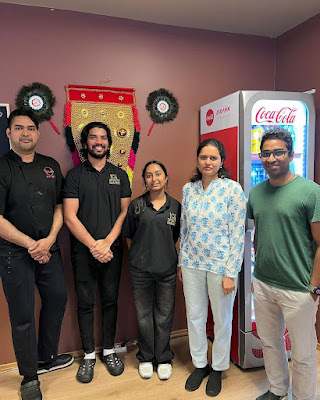


Captions: (From left) Owner Susheel Hadigal, Praggnanandhaa Rameshbabu, Vaishali, Nagalakshmi, and Nitish Kamath; Koneru Humpy (second from right)
When thefood reminds one of home
By ShevlinSebastian
In lateMay, there is a top-tier chess championship, which is held in Stavanger,conducted by Norway Chess. This year, ‘Spisoh’, a South Indian restaurant,became a sponsor.
“Ourthought process was simple,” said Nitish Kamath, a co-owner. “All the Indianplayers who take part are primarily from South India. So we thought we wouldbecome a sponsor and offer our food free for all the players.”
KoneruHumpy, India’s No 1 and world No 4, was an early customer. “Koneru orderedearlier in the day. When her match concluded at 9 p.m., she came to therestaurant and collected it,” said Nitish. “She has been ordering every day.”Her favourite is Hyderabadi biryani, Kodi Vepudu (Andhra-style chilly chicken)and tomato rasam.
On May 31,during the rest day, rising star, grandmaster Rameshbabu Praggnanandhaa, camefor dinner. He was accompanied by his sister Vaishali, a grandmaster herself,and mother Nagalakshmi.
Praggnanandhaaasked Nitish, “What do you recommend?”
Nitishsaid, “Since you are from Tamil Nadu, why don’t you have Kozhi (Chicken) Milagucurry?”
He said,“Okay, fine.”
Praggnanandhaaopted to have it with Kerala parotta.
Vaishaliand Nagalakshmi ordered ghee dosa.
A smilingNitish told Nagalakshmi, “Praggnanandhaa always looks very serious.”
Nagalakshmireplied, “I always tell him to smile, but he is in a different world during atournament.”
Theylaughed.
Last year,D. Gukesh, another leading Indian grandmaster, came to the restaurant alongwith his father Dr. Rajnikanth, an ENT surgeon. While Gukesh came sporadicallyduring the two-week tournament, his father came daily. He ordered the samedish: lamb masala.
Because oftheir sponsorship, the co-owners could make the ceremonial first move in mostmatches. After it is done, the player brings the pawn back to the first row andthe play starts. American player Hikaru Nakamura, of Japanese origin, toldco-owner Raghu Bala, “You can make any move. I will continue from there.”
So Raghuplayed the Sicilian Gambit. Nakamura, as promised, carried on, and ended upwinning the match against Praggnanandhaa. “Raghu got very excited,” saidNitish.
The storyof Spisoh
The idea ofa restaurant came casually. A few Indians worked in the IT and oil and gasindustry in Stavanger (550 kms from Oslo). They had been living in this city of1.4 lakh people for over 15 years. Rohini Sasidharan, the wife of one Indianimmigrant, Rathish Kunnath, found it difficult to get a job. So, she suggestedthe idea of opening a restaurant with her husband and his friends.
“We werecautious, as none of us have any experience in the food industry,” said Nitish.They discovered there were eight Indian restaurants in Stavanger. They were runby Indians, Pakistanis and Bangladeshis. All of them provided similar fare likebutter chicken, chicken tikka masala, paneer and nan. So, the group thought theyshould stick to their South Indian roots, as most of them were from Kerala. Andhence they decided to start a South Indian restaurant.
“We wantedto cultivate a new taste in this region,” said Nitish. The name, Spis-oh,is a combination of Spiser (Eating in Norsk) and Khaoh (Eating inHindi)
In July2021, during Covid, they rented a small kitchen in a remote area in Stavangerand began as a takeaway outlet. “The idea was to test out whether this type offood would have takers,” said Nitish.
At this time,Raghu met a chef, Aswin Sreekanthan, who had lost his job during Covid. He hadbeen working in an Italian restaurant in Oslo and previously headed a chain ofhotels in Portugal. Aswin told Raghu he was from Chennai and was keen to remainin Norway. So, they hired him. Soon, the takeaway became popular.
On March 4,2023, they started the 30-seater Spisoh, in Løkkeveien, which is the citycentre. There are five major hotels in the area.
Asked abouttheir clientele, Nitish said, “From Tuesday to Thursday, Norwegians andEuropeans who are travelling to Stavanger for business meetings come to have abite.”
FromThursday to Saturday, it is local Norwegians and Indians. The population ofIndians is around 3500.
The localPakistanis, Sri Lankan, and Bangladeshis are also customers. “Many Pakistanishave only partaken of North Indian food,” said Nitish. “So having South Indianfood is a novelty for them, especially idli and dosa.”
As fortheir future plans, Nitish said, “There is a social element behind continuing.We saved our chef, Aswin, from returning to India and got him a job contract.Now he has brought his family to Stavanger. Aswin’s son is studying in aNorwegian school, while his wife works in a hotel. Aswin has bought a car.”
A fewmarried women, who have come on a dependent visa, work at Spisoh as kitchenassistants, front-office and cleaning staff. The owners are enabling them toearn an extra income.
Nitishsaid, “It is a bit of a struggle for immigrants in the initial years to settledown. Spisoh is about food, but it is also about giving opportunities to theIndian diaspora.”
Andproviding food and bonhomie to chess stars, too.
(Publishedin Sunday Magazine, The New Indian Express, South India and Delhi)
June 11, 2024
Helping to become self-reliant
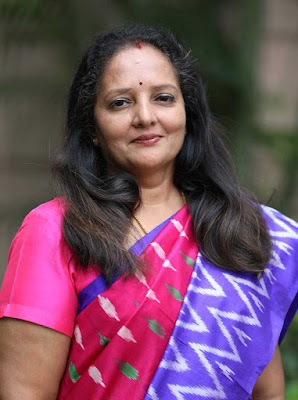
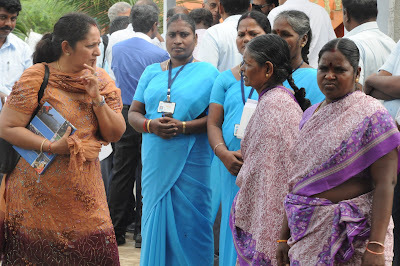
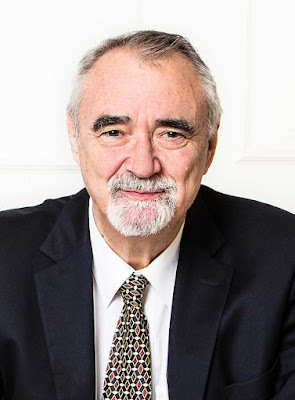 Captions: Dr. Kalpana Sankar; Dr. Kalpana Sankar meeting people; Dr. Percy Barnevik
Captions: Dr. Kalpana Sankar; Dr. Kalpana Sankar meeting people; Dr. Percy BarnevikDr. Kalpana Sankar is the Co-Founder of Hand in Hand India. She has helped lakhs of people to become entrepreneurs
By Shevlin Sebastian
Whenever Dr. Kalpana Sankar thinks about Meera Soundarajan, a smile breaks out on her face.
Meera belonged to the backward Irula community. She stayed in the village of Chinnakadambathur in Thiruvallur District, Tamil Nadu. The family eked out a living by working in brick kilns, going into the forests to cut wood and graze the cattle. They were always on the move. Because of this, Meera and her three younger siblings had to drop out of school.
Thanks to the intervention of Kalpana, Meera was enrolled in school. In 2018, Meera reached Class 10. After her stellar performance in the final exams, Meera won the ‘Pratibha Award’. This is given to meritorious students by the Government of Andhra Pradesh. The other siblings are also studying in lower classes. “They have a bright future,” said Kalpana.
Kalpana’s life changed when she met Dr. Percy Barnevik on May 2, 2004, in Kancheepuram, Tamil Nadu. Percy is a Swedish business executive. On a visit to Tamil Nadu, he saw first-hand the devastating impact of child labour in the silk saree industry. At that time, Kalpana was working with the Tamil Nadu Women’s Development Project.
Percy asked Kalpana whether she would join him in his mission. She accepted the offer. They set up Hand in Hand India.
The organisation has helped women get jobs or become entrepreneurs and free the children to go to school.
“Unless you empower the families, they will not send the children to school,” said Kalpana. The group targeted the mothers by providing looms and sewing machines, at subsidised rates. Later, they began to help the men and the youth.
For the youth, they provided skills training. They learned to become plumbers and electricians and to be eligible for the armed forces. Thereafter, Hand in Hand India began working with farmers.
“We are very keen for people to become entrepreneurs,” said Kalpana. “So we are willing to give loans. We provide options for the trade they could enter into. In that way, they can become independent. We try to inculcate the concept that everybody has potential.”
To provide finance to Hand in Hand India, Kalpana set up the Belstar Microfinance Limited. She is the Managing Director. The Muthoot Group is a major shareholder. The funding is provided by philanthropists, both in India and abroad, corporates and the government.
But there has been a dark spot: the Covid epidemic. “It was a major setback,” said Kalpana. “Many entrepreneurs are yet to recover completely from the financial blow.” So far, the organisation, which has branches in 18 states, has helped 40 lakh women.
Recently, Kalpana saw film director Kiran Rao’s well-received ‘Laapataa Ladies’ on Netflix. In the film, a lost bride, at a railway station, cannot tell the name of her new husband’s village to the stationmaster. So, he is unable to help. Kalpana told her staff to show it to the women who come to their centres. She hoped they would understand the importance of education.
Kalpana’s parents also stressed to her the importance of education. She has a doctorate in Nuclear Science and Women’s Studies and Self-Help Groups. And an Executive MBA from the prestigious TRIUM through modules in London, Paris and New York.
Asked whether the middle class lives in a cocoon, Kalpana said, “I don’t blame anybody. For various reasons, there is a rich/poor divide. So people are self-absorbed. What they need is sensitisation. Once they become aware of poverty and issues relating to it, they do reach out to help.”
One way for early sensitisation is for students of schools and colleges to spend time in the villages. “Only then will they understand what is happening. Then they will be able to contribute in a way to bridge the divide,” said Kalpana.
Most people are not sure whether state governments are helping the poor or not. But Kalpana said that everybody is doing something. “But because of our huge population not everybody can get the benefits,” she said. “The good news is that numerous people have moved from the ‘below poverty line’ to the middle class. They have bought TVs, refrigerators and two-wheelers. Many are determined to educate their children.”
But Kalpana has a suggestion. Central and State governments should set up programmes to encourage entrepreneurship. “Then the people will be able to generate incomes and be contributing members of society,” she said.
(Published in the Sunday Magazine, The New Indian Express, South India and Delhi)
June 7, 2024
An upside-down view
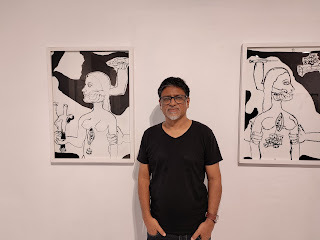
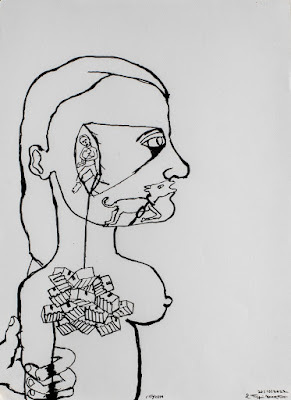
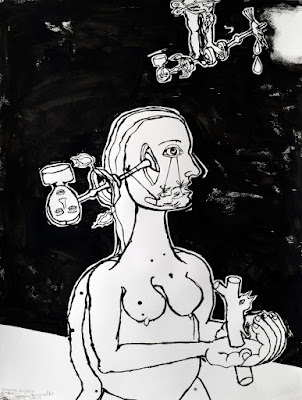
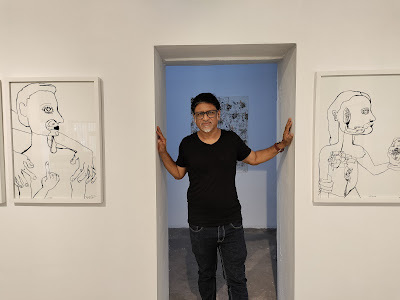 Artist Zakkir Hussain uses inverted logic in his drawingsBy Shevlin Sebastian On most days, artist Zakkir Hussain would stand at the window of his studio at Kadavanthra, Kochi. Mango and drumstick trees are growing in his backyard. Often, he would see a sparrow fly in and peck at a mango. He wondered, in the name of development, if the tree was cut down, would the bird have a memory of the tree? Or if the sparrow died, would the tree have a recollection of it? Zakkir felt that everything on earth was under threat, be it human beings, animals, birds, trees, and nature. Such was the precariousness of life. Over the past three years, he did a series of brush drawings using Indian Ink. Around 54 works are on display at the Berth Art Gallery in Mattancherry. The drawings range in size from 30” x 22” and 28” x 22”. “I like Indian ink because it is risky,” he said. “You cannot make tonal variations. Black or white is the only possibility. This is the best way to convey my present moods and thoughts.” Zakkir titled his work ‘Obliterated Stories’. He wanted to show that the recently implemented crime laws in India are obliterating the concept of personal freedom. “I want to highlight the social tensions,” said Zakkir. “The relationship between human beings should be harmonious. They should be a beacon of light to each other. People should express kindness, love and benevolence.” At first glance, you realise Zakkir has negated the idea of logic in his work. There is a drawing of a young woman in which her breast is exposed. On the left side of the drawing, a male hand is clutching her arm. Behind her eyes, there is a drawing of a mother and child. From there, a line goes downwards and at the end, there are a series of houses hanging upside down.“Through the houses, I wanted to show that women, sometimes, are forced to leave from one place to another,” Zakkir said. A dog is visible near her open mouth. It is as if the woman wants to speak but cannot do so. “The girl is going through an inner trauma. She has no language to express herself because society does not allow her,” said Zakkir. Another drawing is of a young woman with exposed breasts. In her hand, she is holding the branch of a tree which has impaled her palm. A sparrow sits on the branch. From the ear, a Kerala traditional lamp juts out. At its end, there is an image of an upside-down face of a girl. There is another image of a bird whose beaks have been tied with a string. As to his influences, Zakkir said that he has drawn inspiration from artists like Somnath Hore, Benode Behari Mukherjee, Ramkinkar Baij, and KP Krishnakumar. So far, he has had a successful career. Zakkir has exhibited at the Vadehra Art Gallery in Delhi, Gallery Ske in Bangalore, Gallery OED, Kochi, The Guild Art Gallery, Mumbai, Conflictorium, Ahmedabad, Gallery White, Baroda, Zuzeum Art Centre, Riga, Latvia and Gallery Krinzinger, Vienna. He took part in the inaugural edition of the Kochi Muziris Biennale. At present, Zakkir is on a two-month residency at a private museum in Zurich. Beginnings Zakkir got interested in art from an early age. He grew up in the village of Chadiroor in Alleppey district. For his Plus Two, he studied at Maharaja’s College in Kochi. He was a Left sympathiser. One of his friends, Sabu Dinesh, asked Zakkir to do some drawings on some posters. Instead of political slogans, Sabu used poems from some of Latin America’s greatest poets, like Pablo Neruda and Octavia Paz. So Zakkir did drawings, using Indian Ink, to match the words. Zakkir and Dinesh pasted these posters in public spaces like bus stops and shop windows. “I felt excited because I had done a sort of social communication,” said Zakkir. “The positive response from the people also got me interested in art.” Zakkir got admission to do a degree course at the College of Fine Arts in Thiruvananthapuram. During this period, he met and fell in love with Sreeja P, an aspiring artist. They got married in 1999. Both did a course in graphics at the Maharaja Sayajirao University in Baroda. Later, they settled in Kochi. While Zakkir has been a full-time artist since 2004, Sreeja teaches at a nearby school. They have a son who is doing his MSc at the University of Freiburg, Germany. Asked to sum up his work, Zakkir said, “I want to develop a new language, thought processes and metaphors. It is an ongoing process.”(Published in The Sunday Magazine, The New Indian Express, South India and Delhi)
Artist Zakkir Hussain uses inverted logic in his drawingsBy Shevlin Sebastian On most days, artist Zakkir Hussain would stand at the window of his studio at Kadavanthra, Kochi. Mango and drumstick trees are growing in his backyard. Often, he would see a sparrow fly in and peck at a mango. He wondered, in the name of development, if the tree was cut down, would the bird have a memory of the tree? Or if the sparrow died, would the tree have a recollection of it? Zakkir felt that everything on earth was under threat, be it human beings, animals, birds, trees, and nature. Such was the precariousness of life. Over the past three years, he did a series of brush drawings using Indian Ink. Around 54 works are on display at the Berth Art Gallery in Mattancherry. The drawings range in size from 30” x 22” and 28” x 22”. “I like Indian ink because it is risky,” he said. “You cannot make tonal variations. Black or white is the only possibility. This is the best way to convey my present moods and thoughts.” Zakkir titled his work ‘Obliterated Stories’. He wanted to show that the recently implemented crime laws in India are obliterating the concept of personal freedom. “I want to highlight the social tensions,” said Zakkir. “The relationship between human beings should be harmonious. They should be a beacon of light to each other. People should express kindness, love and benevolence.” At first glance, you realise Zakkir has negated the idea of logic in his work. There is a drawing of a young woman in which her breast is exposed. On the left side of the drawing, a male hand is clutching her arm. Behind her eyes, there is a drawing of a mother and child. From there, a line goes downwards and at the end, there are a series of houses hanging upside down.“Through the houses, I wanted to show that women, sometimes, are forced to leave from one place to another,” Zakkir said. A dog is visible near her open mouth. It is as if the woman wants to speak but cannot do so. “The girl is going through an inner trauma. She has no language to express herself because society does not allow her,” said Zakkir. Another drawing is of a young woman with exposed breasts. In her hand, she is holding the branch of a tree which has impaled her palm. A sparrow sits on the branch. From the ear, a Kerala traditional lamp juts out. At its end, there is an image of an upside-down face of a girl. There is another image of a bird whose beaks have been tied with a string. As to his influences, Zakkir said that he has drawn inspiration from artists like Somnath Hore, Benode Behari Mukherjee, Ramkinkar Baij, and KP Krishnakumar. So far, he has had a successful career. Zakkir has exhibited at the Vadehra Art Gallery in Delhi, Gallery Ske in Bangalore, Gallery OED, Kochi, The Guild Art Gallery, Mumbai, Conflictorium, Ahmedabad, Gallery White, Baroda, Zuzeum Art Centre, Riga, Latvia and Gallery Krinzinger, Vienna. He took part in the inaugural edition of the Kochi Muziris Biennale. At present, Zakkir is on a two-month residency at a private museum in Zurich. Beginnings Zakkir got interested in art from an early age. He grew up in the village of Chadiroor in Alleppey district. For his Plus Two, he studied at Maharaja’s College in Kochi. He was a Left sympathiser. One of his friends, Sabu Dinesh, asked Zakkir to do some drawings on some posters. Instead of political slogans, Sabu used poems from some of Latin America’s greatest poets, like Pablo Neruda and Octavia Paz. So Zakkir did drawings, using Indian Ink, to match the words. Zakkir and Dinesh pasted these posters in public spaces like bus stops and shop windows. “I felt excited because I had done a sort of social communication,” said Zakkir. “The positive response from the people also got me interested in art.” Zakkir got admission to do a degree course at the College of Fine Arts in Thiruvananthapuram. During this period, he met and fell in love with Sreeja P, an aspiring artist. They got married in 1999. Both did a course in graphics at the Maharaja Sayajirao University in Baroda. Later, they settled in Kochi. While Zakkir has been a full-time artist since 2004, Sreeja teaches at a nearby school. They have a son who is doing his MSc at the University of Freiburg, Germany. Asked to sum up his work, Zakkir said, “I want to develop a new language, thought processes and metaphors. It is an ongoing process.”(Published in The Sunday Magazine, The New Indian Express, South India and Delhi)
May 31, 2024
An extraordinary life
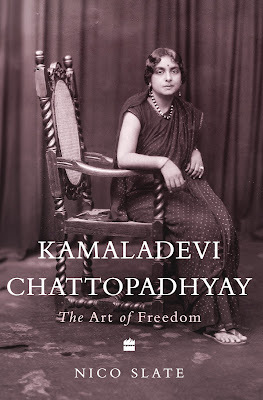
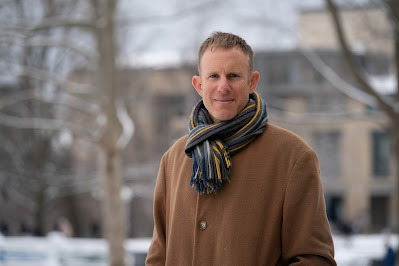
In this well-researched biography on Kamaladevi Chattopadhyay, historian Nico Slate delves into the life of one of the great women achievers of India in the 20th centuryBy Shevlin Sebastian Kamaladevi Chattopadhyay got the first shock of her life when her beloved father, Dhareshwar Ananthya, a Chitrapur Saraswat Brahmin, suddenly passed away. She was only seven years old. The second shock was to learn that because her father had not left a will behind, the vast property went to a stepbrother. ‘I woke up from a daze,’ wrote Kamaladevi. ‘This was what Mother had been alerting me about. Women had no rights and we should qualify to stake our claims and assert them. This question was not of possessions but of principle.’ Worried about her daughter’s future, her mother Girijabai arranged for her, at age 11, to get married. The groom was the son of one of Mangalore’s wealthiest men, Nayampalli Subbarao. The boy was a few years older. A little over a year later, her husband died. Now, Kamaladevi had become a child widow and expected to remain one for the rest of her life. In a book she wrote called, ‘The Awakening of Indian Women’ (1939), Kamaladevi wrote, ‘Widows were souls in agony. They were relegated to a life of servility with scant regard for their feelings or needs. They are even regarded as objects of ill-omen.’ When you read the book, ‘Kamaladevi Chattopadhyay – The Art of Freedom’, by historian Nico Slate, you realise she is one of the great women achievers of India in the 20th century. Kamaladevi handled a massive refugee rehabilitation programme, at today’s Faridabad, following the partition of India in 1947. She was the force behind the renaissance of handicrafts and handloom all over the country. Kamaladevi set up several institutions. These included the Sangeet Natak Akademi, the National School of Drama and the Crafts Council of India. Kamaladevi was also a driving force in the Independence movement. She was close to Mahatma Gandhi and Jawaharlal Nehru. And because of that proximity, she dared to stand up to Gandhi. In 1930, Gandhi set off in a procession, from Sabarmati Ashram to Dandi, a distance of 275 kms, to protest the salt laws of the British. To her astonishment, Kamaladevi found out that there were no women participants. She met Gandhi in a small town on the way and told him, “The significance of a non-violent struggle is that the weakest can take an equal part with the strongest and share in the triumph.” Gandhi had no option but to permit women to take part. When Gandhi realised Kamaladevi was having a contentious relationship with senior Congress leader Sardar Patel, he encouraged her to spend time with him. So, Kamaladevi went to Patel’s home at Bardoli (35 kms from Surat). Patel gave her a tour of his garden and orchard. This changed her understanding of Patel, the person. She wrote: ‘Here was a person other than the renowned ‘Iron Man’ handling seedlings with incredible sensitivity and with a rare soft light in his usual stern eyes.’ Slate also tackled the rumours of whether Kamaladevi had a romantic relationship with Nehru. There was nothing to show that there was a physical connection. But Kamaladevi wrote with a great deal of tenderness about Nehru. This could have raised eyebrows. Here is a section: ‘The far-away look in his eyes speaks of hidden dreams. Once that deep-set mouth must have broken into smiles oftener; those firm lips melted into softer lines; the stern eyes danced with a more tender light. Those delicately shaped hands, the exquisitely chiselled feet, all so eloquent of a dream-laden soul, are today masked by the hard relentless marks of terrible struggle, which he so characteristically embodies in himself as the representative of a nation in the throes of a fierce battle.’In her personal life, Kamaladevi faced many challenges. She got divorced, after 22 years, from a philandering Harindranath Chattopadhyay. He was a poet, dramatist, actor and musician, and the younger brother of political activist Sarojini Naidu. Their son Rama felt neglected. That’s because Kamaladevi, a world traveller, struggled to raise her son while remaining dedicated to the freedom struggle and being repeatedly imprisoned.This is a deeply researched book. It provides an in-depth look at this magnificent personality. Slate is a Professor of History and Head of the Department of History at Carnegie Mellon University, USA. This is the third book in the ‘Indian Lives’ series. The book is edited and curated by noted historian and writer Ramachandra Guha.In the foreword, Guha has provided an interesting comparison: ‘Perhaps only Rabindranath Tagore matched Kamaladevi in the range of multiple careers she led and the diverse social worlds she enriched.’(Published in the Sunday Magazine, The New Indian Express, South India and Delhi)
May 9, 2024
In the solitude of a human mind
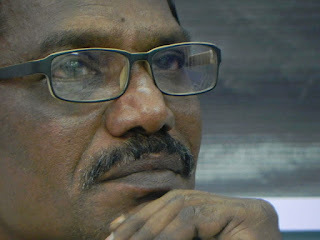
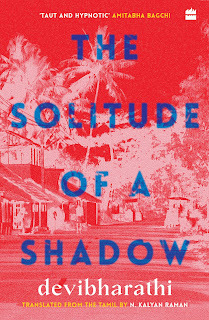
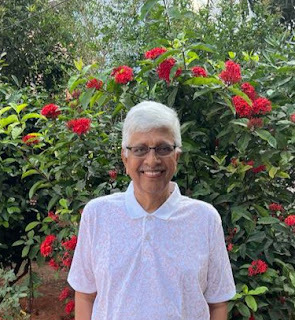 Tamil writer Devibharathi has written a gripping novel about revenge, called‘The Solitude of a Shadow’
Tamil writer Devibharathi has written a gripping novel about revenge, called‘The Solitude of a Shadow’ By Shevlin Sebastian
The first sentence of ‘TheSolitude of a Shadow’ written by veteran Tamil writer Devibharathi, and nicelytranslated by N. Kalyan Raman, creates a sense of foreboding: ‘Karunakaran hadturned up before us like an evil spirit after nearly thirty years.’
This is thethought process of the nameless, first-person protagonist, who is a clerk in agovernment school. Let us name him Rajasekaran, for ease of narration.
Karunakaran, the owner of a loan shop, had come to see the headmaster. It wasclear from the reaction of the headmaster and the staff that he was a man ofinfluence. Later, Rajasekaran came to know that Karunakaran was a successfulentrepreneur and the president of the school’s Parent-Teacher Association. Itwas through his efforts new classrooms had been made.
The reason forRajasekaran’s shocked reaction was that Karunakaran had raped his sister Sharadathree decades ago. Their mother had told Sharada: “It’s nothing. You will be allright.” Rajasekaran was only 12. And he remembered shouting at Karunakaran, “Nomatter how long it takes, I won’t rest until I have chopped you into pieces.I’ll avenge this, da.”
Karunakaran laughed. Then he told their mother, “The boywatches a lot of movies, it seems. Such a small runt. You are no bigger than acrab, but you stood there with a sickle in your hand and threatened to kill me.”Unfortunately, the siblings could not inflict any revenge.
That evening, whenRajasekaran mentioned the reemergence of Karunakaran to Sharada, Devibharathiwrites: ‘the smouldering embers of her vengeance had begun to shed the layers ofash deposited by time.’ After calming down, Sharada asked her brother to wreakvengeance on Karunakaran.
Rajasekaran wrote an anonymous letter describing therape of Sharada. He sent it by post to Karunakaran’s home.
‘I wanted him to feelon his dead tongue the salt of the tears that had flowed from Sharada’s browneyes as she stood before him trembling like a wounded bird,’ writesDevibharathi. ‘He would never have imagined that I would follow him like avengeful serpent and that he would struggle to protect himself from the panicthat would follow.’
Now begins the cat-and-mouse game between Rajasekaran andKarunakaran, as they interact with one another all the time. It is intriguing,suspenseful and mysterious. No rising heat wave or a falling water table candistract the reader from enjoying this superb novel.
Devibharathi has been agovernment employee, political activist, a managing editor of a literarymagazine and scriptwriter. He won the Sahitya Akademi award for 2023. ‘NizhalinThanimai’ (‘The Solitude of a Shadow’), published in 2012, is his first novel.
In four decades, Devibharathi has published two short story collections, fournovellas, four novels, a play and two non-fiction anthologies which contain hisessays and memoirs. One hopes that more books of Devibharathi will be translatedinto English.
(Published in the Sunday Magazine, The New Indian Express, SouthIndia and Delhi)
May 4, 2024
The film that scaled the heights
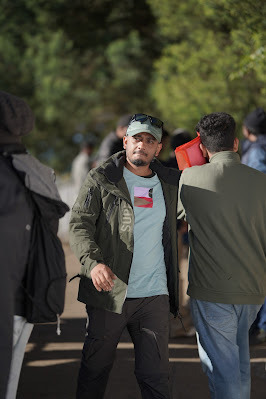
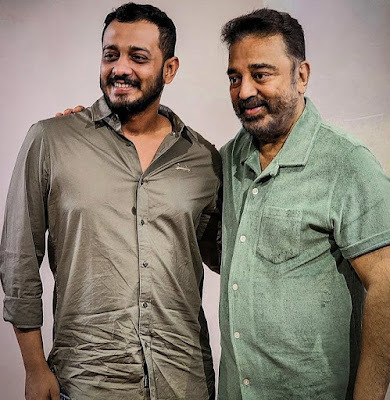
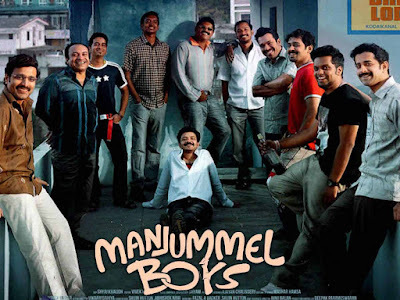 Chidambaram S Poduval, the director of ‘Manjummel Boys’, talks about how the idea for the film came to him and his meeting with Tamil film legend Kamal HaasanBy Shevlin Sebastian Shawn Antony was the producer of director Chidambaram’s first film, ‘Jan E Man’ (2021). One day, he told Chidambaram a story of a group of boys who had gone to the Guna Caves (elevation: 2230 metres) in Kodaikanal in 2006. One of them, Subhash, while crossing a crevice, fell through a hole and plunged to a depth of 120 feet. The rescue services personnel were reluctant to go down, while holding onto a rope. So, one boy, Siju David, volunteered to do so. In the end, he could pull Subhash up towards safety. So, Chidambaram, along with Shawn, met the boys at Siju’s house at Manjummel, near Kochi in mid-2022. After hearing their narration, Chidambaram realised that this would make a good film. For research, Chidambaram went to the Guna Caves. One day, at 6 am, in December 2022, he entered the caves for the first time. Chidambaram had heard many stories of people slipping through the various holes. Nobody had found their bodies. The forest guard gave Chidambaram a lemon. He told Chidambaram he needed it to ward off negative energy. When Chidambaram was strolling around, he realised there were over 100 hidden holes. “It was too dangerous,” he said. Chidambaram experienced the smell of the decomposition of the plants. He also noticed the wet earth and the plastic waste and food thrown by the tourists. The caves acted like a funnel for the neighbouring areas. He had to contend with the odour of monkeys, dead bats and methane gas. “It has a psychological effect on you,” he said. “There is a cliff. People jump off it. The locals dubbed it ‘Suicide Point’. Murders have also taken place.” Thereafter, Chidambaram returned to Kochi. He took one-and-a-half years to write the script. Since the actual Guna Caves were too dangerous to shoot, the crew built a replica at a warehouse in Perumbavoor, 38 kms from Kochi. For the frame, they used metal and fibre for the rocks. “The height was about 40 feet,” said Chidambaram. “We used VFX to create a further height.” Set designer Ajayan Chalissery designed it. One morning, Chidambaram surveyed the cave. Standing behind him were two senior technicians working in the flame unit. Both were from Andhra Pradesh. They had just arrived and did not know anything about the subject of the film. One man turned to the other and said, “This place looks like Guna, don’t you think?” Chidambaram looked back and said, “Why did you say that?” The man replied, “Sir, I worked in Kamal Haasan’s ‘Gunaa’ (1991). We had shot inside the caves.” It was at that moment, that Chidambaram realised Ajayan and his team had nailed the recreation. Asked why the film became a superhit, having grossed over Rs 200 crore worldwide, Chidambaram said, “Every village will have a bunch of mischievous brats who fall into trouble. It is a survival thriller. This is a universal theme: a triumph against the odds. Also, ‘Manjummel Boys’ is a visually told story. Language is not a barrier.” The film received an exceptional reception in Tamil Nadu. One of the main reasons is that, at the beginning, a video is being played in a restaurant. It featured the hit song, ‘Kanmani Anbodu Kadhalan’ from ‘Gunaa’. Kamal Haasan played the hero. Another factor that helped was that since the movie was mostly set in Tamil Nadu, about 60 percent of the dialogue was in Tamil. Chidambaram sent Kamal the CD of the film. Kamal arranged for the movie to be shown at the Tagore Film Centre in Adyar. He invited his friends, family and the Manjummel Boys team.“I watched the movie sitting next to Kamal Sir, and Santhana Bharathi (director of ‘Gunaa’)” said Chidambaram. “He told me it was moving to hear his voice in the film.” In the ‘Gunaa’ song, it was Kamal who sang the male playback, along with legendary singer S. Janaki. For Chidambaram, the shock was to realise he was talking to a legend and not feeling he was in the presence of one. “He is so humble that you get humbled as a result,” said Chidambaram. “Another facet that I understood was that Kamal Sir is a student of cinema. He has never rested on his laurels. Even at his age [69], Kamal Sir exudes energy and happiness and wants to make more and more films. His drive is higher than ever.” Asked whether he feels any pressure about his next film, Chidambaram said, “No. I am only reminded of this when journalists, friends and relatives ask me this question. Otherwise, I am fine. My attitude is to approach each film as if it is my first one.” (An edited version was published in The Sunday Magazine, The New Indian Express, South India and Delhi)
Chidambaram S Poduval, the director of ‘Manjummel Boys’, talks about how the idea for the film came to him and his meeting with Tamil film legend Kamal HaasanBy Shevlin Sebastian Shawn Antony was the producer of director Chidambaram’s first film, ‘Jan E Man’ (2021). One day, he told Chidambaram a story of a group of boys who had gone to the Guna Caves (elevation: 2230 metres) in Kodaikanal in 2006. One of them, Subhash, while crossing a crevice, fell through a hole and plunged to a depth of 120 feet. The rescue services personnel were reluctant to go down, while holding onto a rope. So, one boy, Siju David, volunteered to do so. In the end, he could pull Subhash up towards safety. So, Chidambaram, along with Shawn, met the boys at Siju’s house at Manjummel, near Kochi in mid-2022. After hearing their narration, Chidambaram realised that this would make a good film. For research, Chidambaram went to the Guna Caves. One day, at 6 am, in December 2022, he entered the caves for the first time. Chidambaram had heard many stories of people slipping through the various holes. Nobody had found their bodies. The forest guard gave Chidambaram a lemon. He told Chidambaram he needed it to ward off negative energy. When Chidambaram was strolling around, he realised there were over 100 hidden holes. “It was too dangerous,” he said. Chidambaram experienced the smell of the decomposition of the plants. He also noticed the wet earth and the plastic waste and food thrown by the tourists. The caves acted like a funnel for the neighbouring areas. He had to contend with the odour of monkeys, dead bats and methane gas. “It has a psychological effect on you,” he said. “There is a cliff. People jump off it. The locals dubbed it ‘Suicide Point’. Murders have also taken place.” Thereafter, Chidambaram returned to Kochi. He took one-and-a-half years to write the script. Since the actual Guna Caves were too dangerous to shoot, the crew built a replica at a warehouse in Perumbavoor, 38 kms from Kochi. For the frame, they used metal and fibre for the rocks. “The height was about 40 feet,” said Chidambaram. “We used VFX to create a further height.” Set designer Ajayan Chalissery designed it. One morning, Chidambaram surveyed the cave. Standing behind him were two senior technicians working in the flame unit. Both were from Andhra Pradesh. They had just arrived and did not know anything about the subject of the film. One man turned to the other and said, “This place looks like Guna, don’t you think?” Chidambaram looked back and said, “Why did you say that?” The man replied, “Sir, I worked in Kamal Haasan’s ‘Gunaa’ (1991). We had shot inside the caves.” It was at that moment, that Chidambaram realised Ajayan and his team had nailed the recreation. Asked why the film became a superhit, having grossed over Rs 200 crore worldwide, Chidambaram said, “Every village will have a bunch of mischievous brats who fall into trouble. It is a survival thriller. This is a universal theme: a triumph against the odds. Also, ‘Manjummel Boys’ is a visually told story. Language is not a barrier.” The film received an exceptional reception in Tamil Nadu. One of the main reasons is that, at the beginning, a video is being played in a restaurant. It featured the hit song, ‘Kanmani Anbodu Kadhalan’ from ‘Gunaa’. Kamal Haasan played the hero. Another factor that helped was that since the movie was mostly set in Tamil Nadu, about 60 percent of the dialogue was in Tamil. Chidambaram sent Kamal the CD of the film. Kamal arranged for the movie to be shown at the Tagore Film Centre in Adyar. He invited his friends, family and the Manjummel Boys team.“I watched the movie sitting next to Kamal Sir, and Santhana Bharathi (director of ‘Gunaa’)” said Chidambaram. “He told me it was moving to hear his voice in the film.” In the ‘Gunaa’ song, it was Kamal who sang the male playback, along with legendary singer S. Janaki. For Chidambaram, the shock was to realise he was talking to a legend and not feeling he was in the presence of one. “He is so humble that you get humbled as a result,” said Chidambaram. “Another facet that I understood was that Kamal Sir is a student of cinema. He has never rested on his laurels. Even at his age [69], Kamal Sir exudes energy and happiness and wants to make more and more films. His drive is higher than ever.” Asked whether he feels any pressure about his next film, Chidambaram said, “No. I am only reminded of this when journalists, friends and relatives ask me this question. Otherwise, I am fine. My attitude is to approach each film as if it is my first one.” (An edited version was published in The Sunday Magazine, The New Indian Express, South India and Delhi)
April 28, 2024
Reading for the sightless
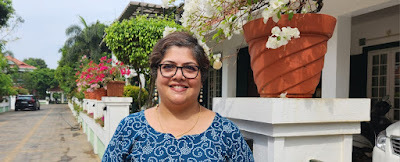


Social worker Devi Krishna runs ‘Hidden Voices’, which provides audio books and magazines for the visually challenged
By Shevlin Sebastian
In 2019, the Kochi psychotherapist Devi Krishna was at a loose end. Yes, she worked as a freelance psychotherapist and also as a Hindi teacher for Classes 3-5 at a leading private school. But her life lacked meaning and purpose.
One day, to pass the time, she had gone to meet a group of friends at Kochi. They were associated with the visually impaired. While there, she met a man named Sudheesh, 42, a visually-challenged teacher. He worked in a school at Tirur (135 kms from Kochi).
Sudheesh recounted to Devi that while he was on his way to school in Malappuram to do his class 10 examinations, he lost his eyesight suddenly. This can happen if you suffer from retinitis pigmentosa. It causes cells in the retina to break down over time and cause an abrupt loss of vision. It came as a shock to him. His life descended into darkness.
Sudheesh said, “The problem for us visually challenged people is that for academic textbooks, there were no audio recordings. We can read by using Braille but many of us prefer to hear. It makes studying easier for us.”
Devi got a brainwave. ‘I could do this,’ she thought.
So she proceeded to make recordings of academic books. She sent it across to Sudheesh. Sudheesh heard it and told Devi it was very good and would fill a lacuna. That was when Devi got the idea that she should set up a library of audio books for the blind.
On April 28, 2019, Devi set up ‘Hidden Voices’. Asked for the reasons behind the name, Devi says, “We prefer to remain discreet in our actions. I adhere to the notion that help rendered should be humble and concealed.”
Today, in the fifth year of ‘Hidden Voices’, Devi, 50, says there are 4753 readers. All are volunteers. They range in age from five to 92. The oldest is the Hyderabad-based Devisetty Venkata Subrahmanyam. “He loves to read for the visually challenged,” says Devi. “Subrahmanyam Sir has a very clear diction.” The other readers live in India, Sri Lanka, Nepal, Australia, Canada, France, Germany, Kuwait, the US, Mexico, and Singapore.
The readers are selected based on their diction, voice tone, and clarity. There should be no background noise like fans or traffic sounds in the recordings.
Once ‘Hidden Voices’ receives a recording, they look for factual errors and mistakes in diction or pronunciation. The team uses software like Adobe Enhance to edit the recordings.
The books that are read include fiction, non-fiction and magazines. They are aimed at students from kindergarten to college. In children’s fiction, the popular titles are the Harry Potter series, as well as the Enid Blyton books.
For older readers, there are autobiographies of Mahatma Gandhi, former Prime Minister Jawaharlal Nehru, and former Indian President APJ Abdul Kalam. There are plays by William Shakespeare and novels by Jane Eyre. Even American author Herman Melville’s classic tale of adventure ‘Moby Dick’ has made it to the list.
The most requested books are in the motivational and self-help categories. Right on top is Rhonda Byrne’s ‘The Secret’. This is followed by Paulo Coelho’s ‘The Alchemist’ and many Osho books. “We have recorded 50,000 pages of Osho,” says Lekshmy. “It is an ongoing project.”
There are academic books, as well as guides for the preparation for the Union Public Service Commission examination. People ask for the Constitution of India, too. Many of the visually challenged opt for law. “For many professions, you need the use of eyes, like as a doctor or a scientist,” says Devi. “So they prefer to be lawyers.”
Incidentally, one reader does not read an entire book of, say, 200 pages. They divide it among four readers to speed up the process. “If it is fiction, listeners do get disoriented when the narrative voice changes,” says Devi. “But for academic books, it is fine.”
One student, Chilaka Nithish, who is from Guntur, Andhra Pradesh, sent an audio message to Devi. Nitish said, “I want to give feedback for a Telugu novel written by Kovalli Lakshmi Narasimha Rao. I thank all the volunteers. It is an interesting book. I listened to all the stories. Thanks once again.”
Aishwarya R, a Chennai-based software engineer, has been reading for the past two years. Aishwarya came to know about ‘Hidden Voices’ through a friend, who had asked for volunteers on social media. In the beginning, Aishwarya read English and Hindi academic books. “Now I read English novels because of a want of time,” she says. “So far, I have done about 80 recordings.”
At present, Aishwarya is reading a book in translation called ‘Shivaji — The Great Maratha’ by the late Marathi writer Ranjit Desai. Asked why she is doing this, Aishwarya says, “This is a kind of social service. Secondly, it enables me to remain in touch with reading.”
The students get the recording if they send a request on WhatsApp or Telegram. The recordings are available in 17 Indian languages.
Devi says they are looking for funding. Many of the visually challenged do not come from financially well-off backgrounds. So, she buys laptops and mobile phones for them. She also pays college fees and provides software upgrades. “So far I have depended on the charity of my friends and well-wishers,” she says. “Now I am approaching corporations to help us with their funds in CSR (Corporate Social Responsibility).”
April 22, 2024
The elephant whisperer
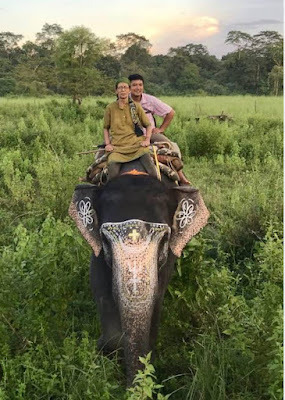
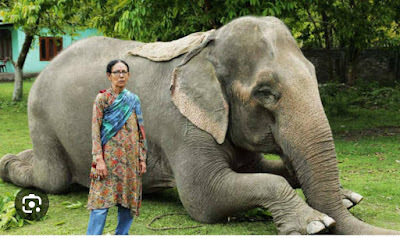
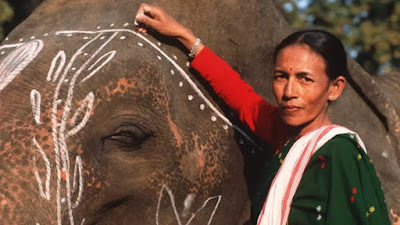
Parbati Barua, the first femalemahout of India, has won the Padma Shri for 2024
By Shevlin Sebastian
On the night of January 25,2024, Parbati Barua had switched on a news channel on the television at herhome in Guwahati. She felt her body tremble when the anchor announced shehad won the Padma Shri (Social Work) for her career as the first female mahoutin India.
A few minutes later, she got acall from a central government official who confirmed the news. But herneighbours did not come, because they knew she went to sleep at 8 p.m. And gotup at 4 a.m.
“My work has finally receivedofficial recognition,” she says. “This was also a recognition of the enormousamount of work mahouts put in. It is a 24/7 job. People will not understandunless they see it first-hand. My heart is always with the mahouts.”
In 1989, Parbati had receivedthe ‘Global 500 – Roll of Honour’ award from the United Nations EnvironmentProgramme for her work in the welfare and management of wild and captiveelephants. There was also a BBC documentary.
Parbati’s elder sister, thelegendary folk singer, Pratima Barua Pandey (1934-2002), had also won the PadmaShri in 1991. She had a tie-up with the legendary Assamese singer BhupenHazarika.
As Parbati drifted off to sleep,a memory came to her mind.
When she was ten years old, oneday her mother Bina said, “Do you know when you saw an elephant for the firsttime?”
As Parbati narrowed her eyes andtried to remember, Bina said, “You will not be able to recall. When you wereone month and 17 days old, your father placed you on the back of an elephant.You had a smile on your face. You fell in love with elephants instantly.”
Parbati belonged to the royalfamily of Gauripur, in Dhubri district in Assam. The family lived near theriver Gadadhar. Her father, Prakritish Chandra Barua had a stable of 40elephants at the back of the house. Because of Prakritish’s immense love forelephants, Parbati also developed a similar affection. “Baba was my guru,” saysParbati. “He taught me how to look after and care for elephants.”
Every day, Prakritish would goto the stables. Parbati accompanied him. One day Prakritish told Parbati, “Givethem love. They will love you in return.” This simple statement remained etchedin Parbati’s mind.
Parbati has eight brothers andsisters. But it was only she who has dedicated her life to looking afterelephants. After observing the work of mahouts for several years, she becameone in 1972. “The best way to learn is through practical experience,” shesays.
Because she is 70 years old,Parbati has only one elephant, Lakhimala, with her. Lakhimala stays in thevillage of Kalpani, around 123 kms from the capital, Guwahati.
As for the food she gives theelephant, it includes banana leaves, green grass and branches of trees. Becausethe village is near the jungle, it is not expensive, as everything isavailable. “But in the town where natural materials are not easily available,it can get expensive,” she says. Sometimes, when it is freezing, she givesLakhimala boiled rice and rum because it helps to keep the elephant warm.
Asked how elephants show love,Parbati says, “It is through the eyes. And you get a feeling that they loveyou. You can gauge it only when you spend time with them. It is a silentlanguage.”
Elephants have similarcharacters like human beings. “Each has a unique personality,” says Parbati.“There are introverted and extroverted elephants. There are leaders andfollowers. Some are very social. Many are benevolent and kind-hearted. Theyhave enormous patience. Only when they reach the limit of their patience dothey get angry. They love children, be it human beings or any other animal liketiger or deer. Elephants will never harm children.”
And they usually get along witheach other within the herd. “They are very co-operative,” says Parbati. Once ina while, there is a quarrel. Then it can be a fight to the death between twoelephants. “Sometimes the fight can last for three days non-stop,” saysParbati. “It is painful to watch. But it is wise not to interfere.”
Asked whether elephants arebetter than human beings, Parbati says, “100 percent. Human beings can be socruel.”
Whenever elephants are sick,injured or become rogue, the authorities in Bengal, Orissa and Assam callParbati. So she is on the road often. “This is my destiny,” she says.
Elephants become rogue forvarious reasons. It is when human beings oppress them, or they get injured.“There is no proper treatment inside the jungle,” says Parbati. “When the painbecomes unbearable, they can get angry. They will attack people at thatmoment.”
The forest department has nooption but to eliminate them. “They become like man-eating tigers,” saysParbati.
ProfessorAloke Kumar, Professor of Communications at the Indian Institute of Managementin Kolkata, who has closely followed Parbati’s career, says, “In an incident inBengal's Medinipur district, a herd of over 50 elephants, went off course andwere wandering towards human habitation. When the authorities couldn't get thesituation under control, they turned to Parbati. With her team and fourelephants, she guided the tuskers back to the jungle.”
The good news, she says, is thatthe elephant population has remained stable. According to the 2017 elephantcensus, the nationwide population stands at 29,964. Karnataka has the highestnumber, at 6395, while Parbati’s home state of Assam has 5719.
Asked about her most memorableexperience, Parbati says it was when she lassoed an elephant in the Kachugaonforest for the first time. “I was only 14 years old,” she says. “I am the onlylady, not only in India, but perhaps in Asia, who has achieved this feat. Ourfamily later sold the elephant. Since it was over 50 years ago, I don’t knowwhether it is alive or passed away.”
(An edited version was published in The Sunday Magazine, The New Indian Express, South India and Delhi)
April 15, 2024
The long and the short of it
 With director Blessy at the Crowne Plaza, Kochi.
With director Blessy at the Crowne Plaza, Kochi.His film, 'Aadujeevitham - The Goat life', has received critical and popular acclaim
April 13, 2024
Creating a sandstorm at the box office
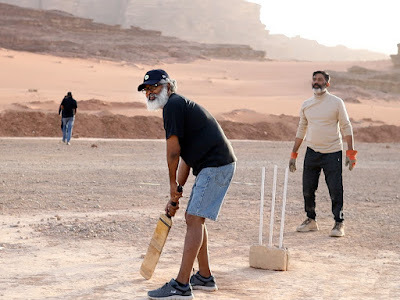
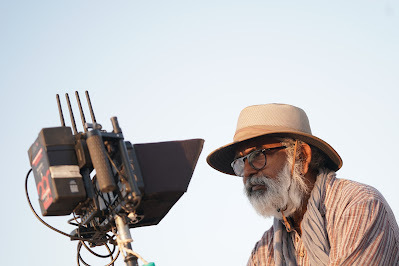
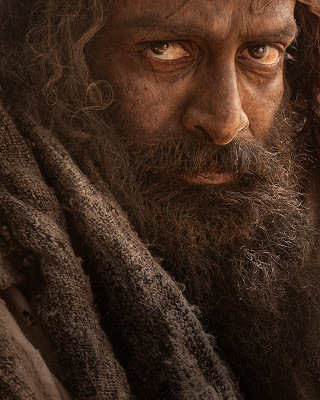 Blessy’s ‘Aadujeevitham- The Goat Life’ is a critical and commercial success. The director talks about the many experiences he went through during the shooting.By Shevlin SebastianAt Director Blessy’s temporary office at the Crowne Plaza Hotel in Kochi, on a summer afternoon, the phone calls keep coming. They are from London, Belfast and North America, where there is a sizeable Malayali population. People are complimenting him on his latest film, ‘Aadujeevitham- The Goat Life’. Blessy always responds with a soft, “Thank you.” The film is a critical and commercial success. His associates, who mill around, are smiling. At 2.45 p.m., Blessy finally has lunch. It comprises a green leafy salad topped off by a glass of watermelon juice. ‘Aadujeevitham’ is based on a best-selling novel by Malayalam writer Benyamin. It is a true story of a labourer called Najeeb Mohammed, who lived in a village called Arattupuzha. To better his economic prospects, he flew to Saudi Arabia in 1993. But he ended up working in the desert, far away from human habitation, looking after 700 goats. The Saudi boss treated him like a slave. After two-and-a-half years of agony, Naseem managed to escape through the desert and return home. Blessy’s first and only choice as hero was Prithviraj. “I knew I needed an actor who would have the dedication,” said Blessy. “The shooting would take around two years. Second, Prithviraj is an intelligent actor.”This was important. When Blessy interviewed Najeeb, he could not articulate the emotions he went through except to say he cried a lot. So Prithviraj had to discover the emotions of a man in the morass of despair. “I knew Prithviraj had the calibre to do this,” said Blessy. Of course, the extraordinary transformation of Prithviraj from a healthy man to become stick and bones, because of a lack of proper food, is a sight to behold. Prithviraj lost over 30 kgs mainly by starving. “Yes, it was an incredible effort by Prithvraj,” said Blessy. But, during the shoot, Blessy faced obstacles. The original plan was to shoot the desert sequences at the Thar Desert in Rajasthan. When he went there, he discovered Indian goats looked different from Saudi Arabian goats. So they decided to import around 100 goats from Saudi Arabia. But to do this, the goats would have to be in quarantine for one month in Dubai. After that, veterinary doctors would inspect the goats to ensure that they had no viruses. Only after that would they issue a certificate. When the goats would disembark at the port of Kandla in Gujarat, they had to remain in quarantine for one month. If any goat fell sick or died during this time, the authorities would cull the entire group. So the director gave up the idea. Blessy went in search of the ideal desert. He travelled to Morocco, Tunisia, Bahrain, Egypt, Oman, and Abu Dhabi. Finally, he zeroed in on Wadi Rum in Jordan, and the Timimoun desert in Algeria. Indeed, the desert visuals in the film are stunning: vast vistas of undulating sands, followed by high mountains and rocky formations. “Members of the Bedouin tribe live there,” said Blessy. “They added to the charm of the place.” But the shooting was very difficult. The logistical challenges were immense. The climatic conditions changed all the time. It could become freezing cold or boiling hot. “A sandstorm could start at any moment,” said Blessy. In the end, they could shoot only between March and May, when the climate was most suitable. In the film, Prithviraj interacts with goats a lot. Asked about the psychology of goats, Blessy said, “They are stubborn and individualistic. It was very difficult to get them to do something. It was after much cajoling they would behave in a certain manner.” But the crew was ecstatic when they found a kid (baby goat) who was loving, obedient and followed commands. “We would feed it biscuits, which it liked a lot,” said Blessy. “The shooting went forward smoothly.”Unfortunately, two days after the shoot, the goat suffered from severe stomach problems. The reason: it had consumed too many biscuits. Then it fell sick and passed away. “That was the saddest moment during the 150-day shoot spread over four years,” said Blessy. “It remains a heartache for me.” (An edited version was published in The Sunday Magazine, The New Indian Express, South India and Delhi)
Blessy’s ‘Aadujeevitham- The Goat Life’ is a critical and commercial success. The director talks about the many experiences he went through during the shooting.By Shevlin SebastianAt Director Blessy’s temporary office at the Crowne Plaza Hotel in Kochi, on a summer afternoon, the phone calls keep coming. They are from London, Belfast and North America, where there is a sizeable Malayali population. People are complimenting him on his latest film, ‘Aadujeevitham- The Goat Life’. Blessy always responds with a soft, “Thank you.” The film is a critical and commercial success. His associates, who mill around, are smiling. At 2.45 p.m., Blessy finally has lunch. It comprises a green leafy salad topped off by a glass of watermelon juice. ‘Aadujeevitham’ is based on a best-selling novel by Malayalam writer Benyamin. It is a true story of a labourer called Najeeb Mohammed, who lived in a village called Arattupuzha. To better his economic prospects, he flew to Saudi Arabia in 1993. But he ended up working in the desert, far away from human habitation, looking after 700 goats. The Saudi boss treated him like a slave. After two-and-a-half years of agony, Naseem managed to escape through the desert and return home. Blessy’s first and only choice as hero was Prithviraj. “I knew I needed an actor who would have the dedication,” said Blessy. “The shooting would take around two years. Second, Prithviraj is an intelligent actor.”This was important. When Blessy interviewed Najeeb, he could not articulate the emotions he went through except to say he cried a lot. So Prithviraj had to discover the emotions of a man in the morass of despair. “I knew Prithviraj had the calibre to do this,” said Blessy. Of course, the extraordinary transformation of Prithviraj from a healthy man to become stick and bones, because of a lack of proper food, is a sight to behold. Prithviraj lost over 30 kgs mainly by starving. “Yes, it was an incredible effort by Prithvraj,” said Blessy. But, during the shoot, Blessy faced obstacles. The original plan was to shoot the desert sequences at the Thar Desert in Rajasthan. When he went there, he discovered Indian goats looked different from Saudi Arabian goats. So they decided to import around 100 goats from Saudi Arabia. But to do this, the goats would have to be in quarantine for one month in Dubai. After that, veterinary doctors would inspect the goats to ensure that they had no viruses. Only after that would they issue a certificate. When the goats would disembark at the port of Kandla in Gujarat, they had to remain in quarantine for one month. If any goat fell sick or died during this time, the authorities would cull the entire group. So the director gave up the idea. Blessy went in search of the ideal desert. He travelled to Morocco, Tunisia, Bahrain, Egypt, Oman, and Abu Dhabi. Finally, he zeroed in on Wadi Rum in Jordan, and the Timimoun desert in Algeria. Indeed, the desert visuals in the film are stunning: vast vistas of undulating sands, followed by high mountains and rocky formations. “Members of the Bedouin tribe live there,” said Blessy. “They added to the charm of the place.” But the shooting was very difficult. The logistical challenges were immense. The climatic conditions changed all the time. It could become freezing cold or boiling hot. “A sandstorm could start at any moment,” said Blessy. In the end, they could shoot only between March and May, when the climate was most suitable. In the film, Prithviraj interacts with goats a lot. Asked about the psychology of goats, Blessy said, “They are stubborn and individualistic. It was very difficult to get them to do something. It was after much cajoling they would behave in a certain manner.” But the crew was ecstatic when they found a kid (baby goat) who was loving, obedient and followed commands. “We would feed it biscuits, which it liked a lot,” said Blessy. “The shooting went forward smoothly.”Unfortunately, two days after the shoot, the goat suffered from severe stomach problems. The reason: it had consumed too many biscuits. Then it fell sick and passed away. “That was the saddest moment during the 150-day shoot spread over four years,” said Blessy. “It remains a heartache for me.” (An edited version was published in The Sunday Magazine, The New Indian Express, South India and Delhi)



